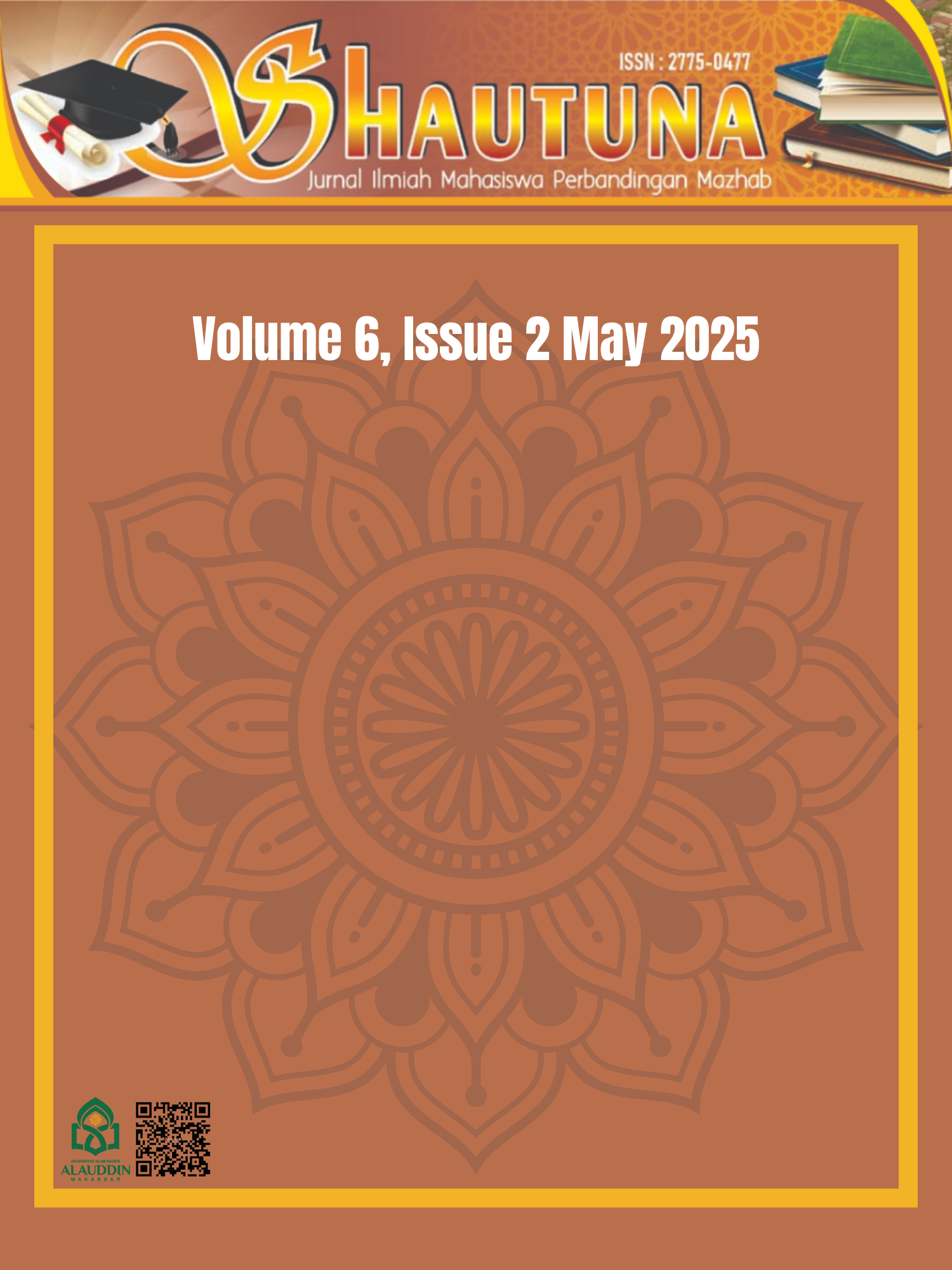Customary Marriage and Social Stratification
The Role of 'Urf in Determining Marriage Partners in the Kajang Indigenous Community of South Sulawesi
DOI:
https://doi.org/10.24252/shautuna.v6i2.55132Keywords:
Marriage, Social Stratification, Urf's Perspective, Kajang Indigenous Peoples, Selection of Marriage PartnersAbstract
This study aims to analyze the influence of social stratification on the selection of marriage partners in the perspective of 'urf in Tanah Toa Village, Kajang District, Bulukumba Regency. The indigenous people of Ammatoa are known to have a strong social structure, which distinguishes between the Puang (nobles) and the Ata (common people), and this has a significant impact on the practice of marriage. This research uses a qualitative method with a theological-normative approach. The main data source is in the form of in-depth interviews with traditional leaders, religious leaders, and local residents. In addition, secondary data were obtained from customary documentation and literature related to social stratification and Islamic law. Data collection techniques are carried out through observation, interviews, and literature studies. The instruments used were a semi-structured interview guide and a voice recording device. Data processing is carried out through the stages of data reduction, data presentation, and conclusion drawn. The analysis was carried out by examining traditional practices and Islamic views on social stratification and inter-caste marriage. The results of the study showed that social stratification affects marriage patterns, where the Puang group tends to marry fellow Puang to maintain social status and lineage. Inter-caste marriages, such as those between Puang and Ata, although customarily possible, are often rejected by families and communities. This norm comes from a long-standing custom. In the perspective of Islamic law, the prohibition is considered 'urf fasid because it is contrary to the principles of justice and equality, which judge a person's glory based on piety, not social status. Islam also gives freedom in choosing a partner as long as it is based on faith and morals. Therefore, in the context of changing social dynamics, this prohibition needs to be reviewed so as not to cause injustice in the socio-religious life of the community.
References
Agustina, Selfia, Moch Iqbal, and Ismail Ismail. “Antropologi Suku Bugis.” DAWUH: Islamic Communication Journal 5, no. 2 (2024): 71–86. https://doi.org/10.62159/dawuh.v5i2.1255.
Al-Bakri, Amhad Abdurraziq, Muhammad Adil Muhammad, Muhammad Abdul Lathif Khalaf, and Mahmud Mursi Abdul Hamid. Tafsir Ath Thabari Jami’ Al Bayan Fi Ta’wil Al Qur’an Terjemah Bahasa Indonesia Jilid 18 Sesuai Dengan Manuskrip Asli Dan Revisi Serta Penyempurnaan Atas Naskah Syaikh Ahmad Muhammad Syakir Dan Syaikh Mahmud Muhammad Syakir. Jakarta: Pustaka Azzam, 2022.
Al-Qurtubi, Muhammad bin Ahmad, and Ahmad Al-Ansari. Al-Jami’li Ahkam Al-Qur’an. Vol. 1428. Beirut: Muassasah al-Risalah, 2006.
An-Nawawi, Imam, Hazim Muhammad, S Ag Wawan Djunaedi Soffandi, Imad Amir, and Isham Ash-Shababithi. Terjemah Syarah Shahiih Muslim. Mustaqiim, 1994.
Anggraini, Nadiyah. “Karakter Muslimah Ideal Dalam Al-Qur’an (Kajian Atas Penafsiran M. Quraish Shihab Dalam Tafsir Al-Mishbah).” Universitas PTIQ Jakarta, 2024.
Azizah, Nurul Wafiq. “Stratifikasi Sosial Dalam Pernikahan Adat Toraja Perspektif Hukum Islam.” Maddika: Journal Of Islamic Family Law 5, no. 1 (2024): 14–30. https://doi.org/10.24256/maddika.v5i1.5014.
Chaesty, Asrie Dwi, and Darmawan Muttaqin. “Studi Literatur: Uang Panai Dalam Adat Pernikahan Suku Bugis Makassar.” Jurnal Sinestesia 12, no. 2 (2022): 701–7. https://sinestesia.pustaka.my.id/journal/article/view/234.
Fasang, Anette Eva, and Silke Aisenbrey. “Uncovering Social Stratification: Intersectional Inequalities in Work and Family Life Courses by Gender and Race.” Social Forces 101, no. 2 (2022): 575–605. https://doi.org/10.1093/sf/soab151.
Gantarang, Gantarang. “Relevansi Penentuan Kuantitas Mahar Dalam Pernikahan Masyarakat Bugis Parepare (Stratifikasi Sosial Kontemporer).” IAIN Parepare, 2022. https://repository.iainpare.ac.id/id/eprint/3341/.
Harisi, Isnain La, Abd Muthalib, and Kurniadi Kurniadi. “Peran Urf Dalam Menentukan Hak Dan Kewajiban Suami-Istri Demi Mewujudkan Keluarga Sakinah.” Al-Usariyah: Jurnal Hukum Keluarga Islam 2, no. 1 (2024): 1–24. https://doi.org/10.37397/al-usariyah.v2i1.585.
Kelley, Heather H., Ashley B. LeBaron, and E. Jeffrey Hill. “Family Matters: Decade Review from Journal of Family and Economic Issues.” Journal of Family and Economic Issues 42, no. 1 (2021): 20–33. https://doi.org/10.1007/s10834-020-09706-8.
M, Faqi Abdul. Al-Lu’lu Wal Marjan: Mutiara Hadits Sahih Bukhari Dan Muslim. Jakarta: Ummul Qura, 2018.
Magfirah, Nurul. “Stratifikasi Sosial Masyarakat Di Kota Makassar.” OSF Preprints, 2022, 1–13. https://doi.org/10.31219/osf.io/82hd7.
Mahmuddin, Ronny, Saifullah bin Anshor, and Hamdan Ngaja. “Tinjauan Hukum Islam Terhadap Pernikahan Beda Kasta (Studi Kasus Desa Ngafan Kabupaten Maluku Tenggara).” BUSTANUL FUQAHA: Jurnal Bidang Hukum Islam 2, no. 1 (April 2021): 148–59. https://doi.org/10.36701/bustanul.v2i1.314.
Malisi, Ali Sibra. “Pernikahan Dalam Islam.” SEIKAT: Jurnal Ilmu Sosial, Politik Dan Hukum 1, no. 1 (2022): 22–28. https://doi.org/10.55681/seikat.v1i1.97.
Muttaqin, Ahmad Izza. “Nilai-Nilai Pendidikan Multikultural Dalam Al-Quran:(Kajian Tafsir Al Misbah QS. Al Hujurat: 13).” Jurnal Darussalam: Jurnal Pendidikan, Komunikasi Dan Pemikiran Hukum Islam 9, no. 2 (2018): 283–93. https://doi.org/10.30739/darussalam.v9i2.230.
Nur, Syahrun, Qadir Gassing, and Musyfikah Ilyas. “Analisis Pemahaman Masyarakat Suku Kajang terhadap Percaraian Ditinjau dari UU No. 16 Tahun 2019.” Qadauna: Jurnal Ilmiah Mahasiswa Hukum Keluarga Islam 4, no. 3 (2023): 632–46. https://doi.org/10.24252/qadauna.v4i3.29167.
Pradnyawati, Ni Putu Ganis, Widjajanti Mulyono Santoso, and Mia Siscawati. “Posisi Perempuan Bali dalam Perkawinan Beda Kasta.” Dharmasmrti : Jurnal Ilmu Agama dan Kebudayaan 22, no. 1 (April 2022): 78–85. https://doi.org/10.32795/ds.v22i1.2757.
Rudianto, Rudianto, Akram Ista, and Nurhikmah Nurhikmah. “Implementasi Hukum Adat Tentang Perkawinan Beda Kasta Dalam Perspektif Hukum Positif.” Jurnal Tana Mana 4, no. 2 (December 2023): 314–21. https://doi.org/10.33648/jtm.v4i2.463.
Sarjana, Sunan Autad, and Imam Kamaluddin Suratman. “Konsep ’Urf Dalam Penetapan Hukum Islam.” Tsaqafah: Jurnal Peradaban Islam 13, no. 2 (2018): 279–96. https://doi.org/10.21111/tsaqafah.v13i2.1509.
Downloads
Published
How to Cite
Issue
Section
License
Copyright (c) 2025 Nurhidayanti Azis, Ikhsan Syahrezi, Syarif Ma'arif Ma'ruf

This work is licensed under a Creative Commons Attribution 4.0 International License.









